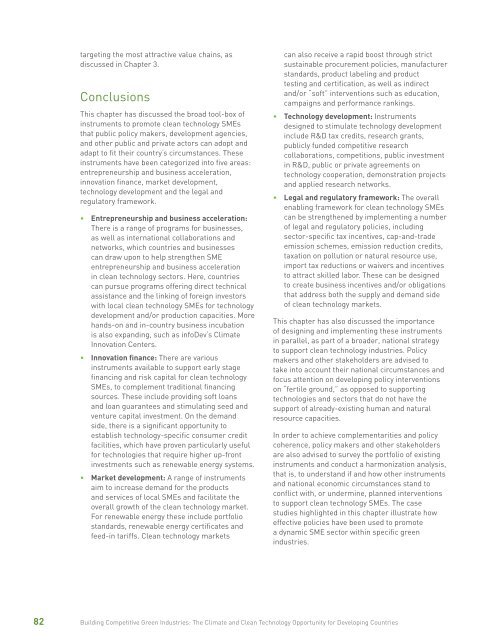Building Competitive Green Industries
green-industries
green-industries
You also want an ePaper? Increase the reach of your titles
YUMPU automatically turns print PDFs into web optimized ePapers that Google loves.
targeting the most attractive value chains, asdiscussed in Chapter 3.ConclusionsThis chapter has discussed the broad tool-box ofinstruments to promote clean technology SMEsthat public policy makers, development agencies,and other public and private actors can adopt andadapt to fit their country‘s circumstances. Theseinstruments have been categorized into five areas:entrepreneurship and business acceleration,innovation finance, market development,technology development and the legal andregulatory framework.• Entrepreneurship and business acceleration:There is a range of programs for businesses,as well as international collaborations andnetworks, which countries and businessescan draw upon to help strengthen SMEentrepreneurship and business accelerationin clean technology sectors. Here, countriescan pursue programs offering direct technicalassistance and the linking of foreign investorswith local clean technology SMEs for technologydevelopment and/or production capacities. Morehands-on and in-country business incubationis also expanding, such as infoDev‘s ClimateInnovation Centers.• Innovation finance: There are variousinstruments available to support early stagefinancing and risk capital for clean technologySMEs, to complement traditional financingsources. These include providing soft loansand loan guarantees and stimulating seed andventure capital investment. On the demandside, there is a significant opportunity toestablish technology-specific consumer creditfacilities, which have proven particularly usefulfor technologies that require higher up-frontinvestments such as renewable energy systems.• Market development: A range of instrumentsaim to increase demand for the productsand services of local SMEs and facilitate theoverall growth of the clean technology market.For renewable energy these include portfoliostandards, renewable energy certificates andfeed-in tariffs. Clean technology marketscan also receive a rapid boost through strictsustainable procurement policies, manufacturerstandards, product labeling and producttesting and certification, as well as indirectand/or “soft” interventions such as education,campaigns and performance rankings.• Technology development: Instrumentsdesigned to stimulate technology developmentinclude R&D tax credits, research grants,publicly funded competitive researchcollaborations, competitions, public investmentin R&D, public or private agreements ontechnology cooperation, demonstration projectsand applied research networks.• Legal and regulatory framework: The overallenabling framework for clean technology SMEscan be strengthened by implementing a numberof legal and regulatory policies, includingsector-specific tax incentives, cap-and-tradeemission schemes, emission reduction credits,taxation on pollution or natural resource use,import tax reductions or waivers and incentivesto attract skilled labor. These can be designedto create business incentives and/or obligationsthat address both the supply and demand sideof clean technology markets.This chapter has also discussed the importanceof designing and implementing these instrumentsin parallel, as part of a broader, national strategyto support clean technology industries. Policymakers and other stakeholders are advised totake into account their national circumstances andfocus attention on developing policy interventionson “fertile ground,” as opposed to supportingtechnologies and sectors that do not have thesupport of already-existing human and naturalresource capacities.In order to achieve complementarities and policycoherence, policy makers and other stakeholdersare also advised to survey the portfolio of existinginstruments and conduct a harmonization analysis,that is, to understand if and how other instrumentsand national economic circumstances stand toconflict with, or undermine, planned interventionsto support clean technology SMEs. The casestudies highlighted in this chapter illustrate howeffective policies have been used to promotea dynamic SME sector within specific greenindustries.82 <strong>Building</strong> <strong>Competitive</strong> <strong>Green</strong> <strong>Industries</strong>: The Climate and Clean Technology Opportunity for Developing Countries


